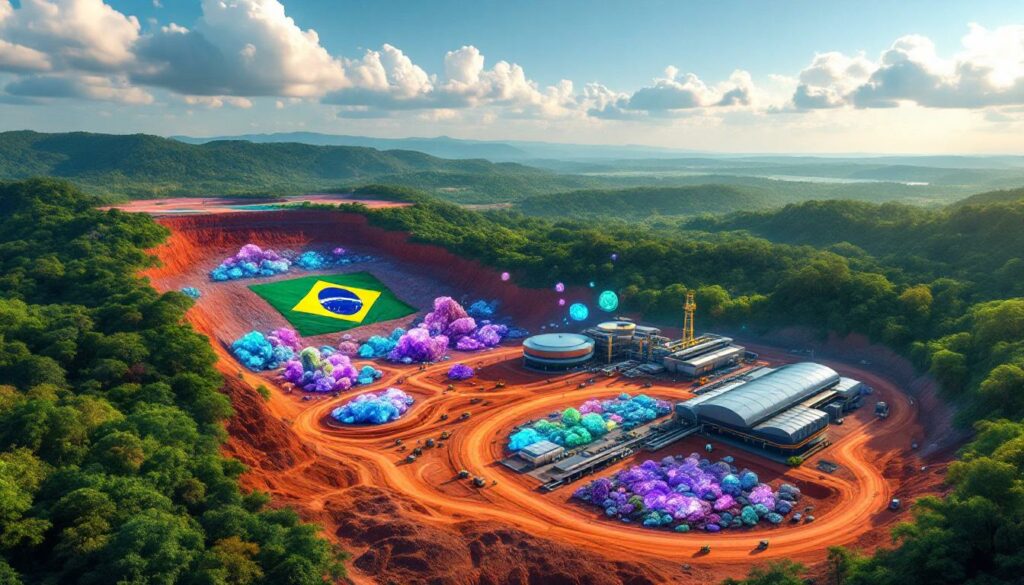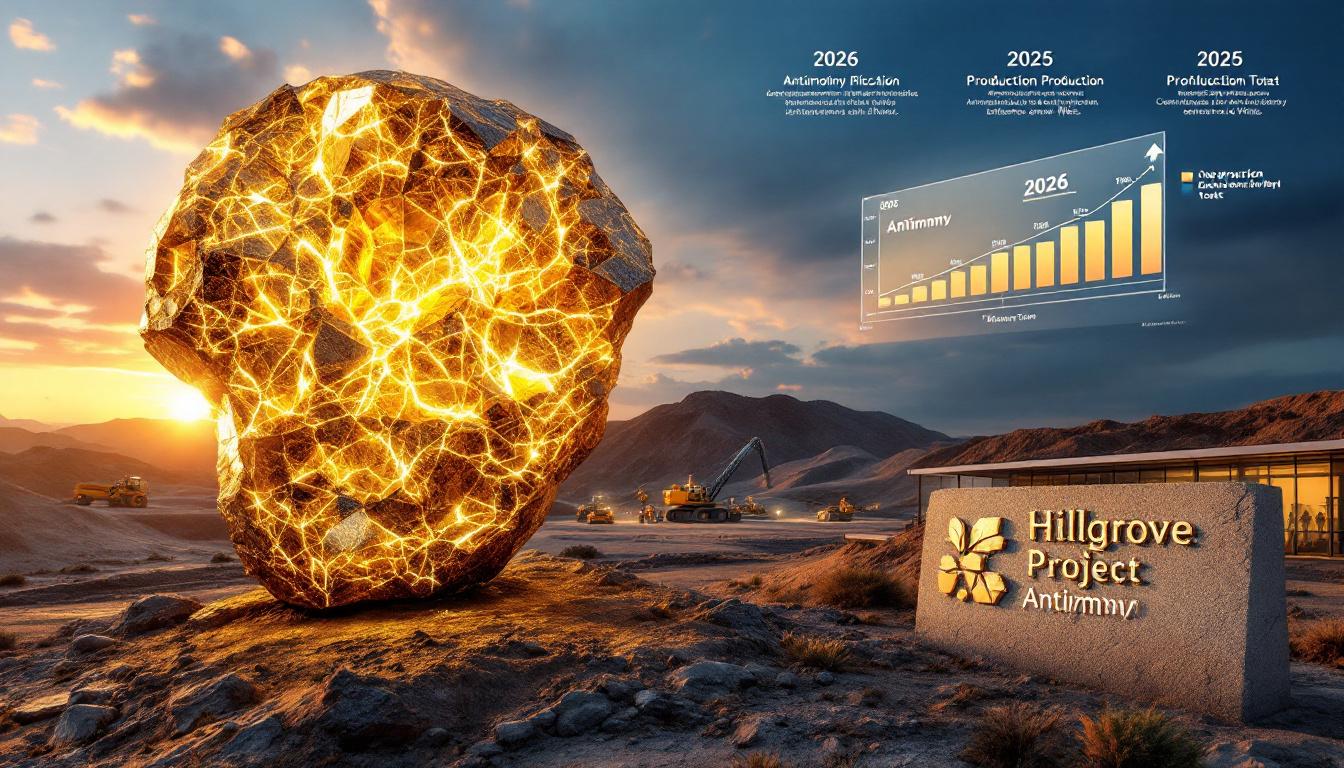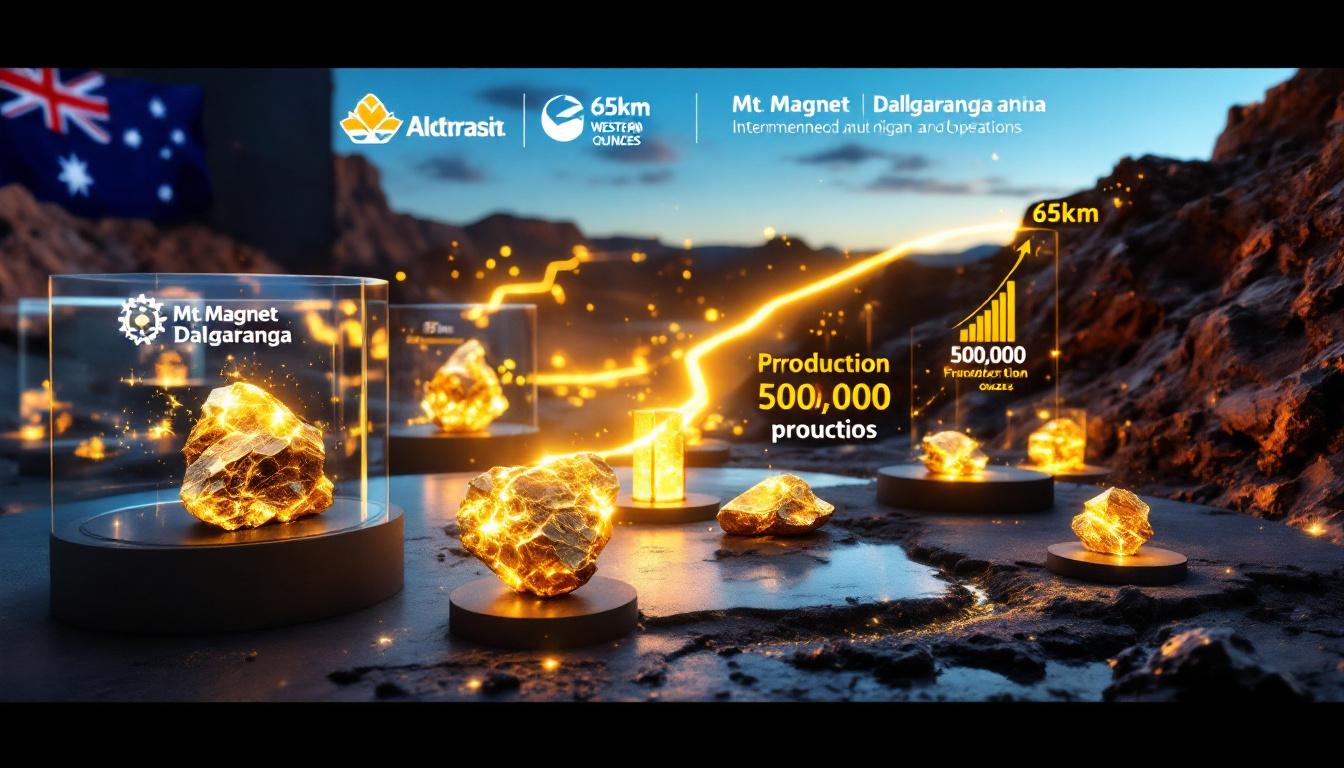Brazilian Strategic Minerals Program: Boosting Meteoric Resources' Caldeira Rare Earths Project
Brazil has taken a significant step toward securing its position in the global critical minerals strategy landscape with the establishment of a comprehensive funding program that directly benefits companies like Meteoric Resources (ASX: MEI) and their flagship Caldeira rare earths project.
What is the Brazilian Strategic Minerals Funding Program?
Understanding Brazil's $1.4 Billion Investment Initiative
The Brazilian government has launched an ambitious $1.4 billion funding program specifically targeting strategic minerals projects across the country. This substantial financial commitment represents one of Latin America's most significant investments in critical minerals development to date. The initiative is jointly managed by two of Brazil's premier financial institutions: the Brazilian Financial Agency for Studies and Projects (Finep) and the National Bank for Economic and Social Development (BNDES).
This program stands as Brazil's answer to similar initiatives elsewhere, such as the U.S. Inflation Reduction Act, which allocated $6 billion for critical minerals, and the European Union's Critical Raw Materials Act. The Brazilian program, however, uniquely focuses on combining both production expansion and technological innovation within the country's borders.
Key Objectives of the Government Funding Initiative
The Brazilian strategic minerals funding initiative pursues several interconnected goals:
- Supporting the development of strategic mineral projects with particular emphasis on rare earths, lithium, nickel, and cobalt
- Expanding domestic production capacity to establish Brazil as a global supplier of critical minerals
- Encouraging technological innovation in mineral processing to maximize efficiency and minimize environmental impact
- Promoting downstream development and value-adding capabilities within Brazil rather than exporting raw materials
- Strengthening Brazil's position in the global strategic minerals overview supply chain, reducing dependency on dominant producers
As Stuart Gale, Managing Director of Meteoric Resources noted, "Finep, BNDES, and the Brazilian government are to be congratulated for establishing a program that encourages new technologies and Brazilian industry development." This statement underscores the program's dual focus on resource development and technological advancement.
How Has Meteoric Resources Positioned Caldeira for Funding?
Caldeira's Inclusion in the Strategic Minerals Program
Meteoric Resources has successfully positioned its Caldeira REE project to qualify for this significant government funding initiative. The company announced in June 2025 that the project has been officially included in the strategic minerals funding program, marking a major milestone in Meteoric's development strategy.
The inclusion follows an extensive evaluation process, with Caldeira meeting key eligibility criteria focused on resource quality, project scale, and strategic alignment with Brazil's mineral development objectives. This qualification represents official recognition of Caldeira's potential contribution to Brazil's critical minerals sector.
Meteoric's Funding Application Details
Meteoric's comprehensive funding application to Finep encompasses a fully integrated development approach including:
- Construction of a pilot processing plant to demonstrate and optimize REE extraction methods
- Development of downstream rare earth separation capabilities to produce individual high-purity rare earth oxides
- Establishment of magnet manufacturing facilities to create high-value finished products
- Scaling and optimization of the Caldeira project to maximize production efficiency
This integrated approach aligns with Brazil's goal of developing domestic supply chains rather than simply exporting raw materials. By including downstream processing and manufacturing facilities, Meteoric has strengthened its application's appeal to program administrators seeking to maximize domestic value creation.
Management's Strategic Vision
According to Meteoric Resources' Managing Director Stuart Gale, "We are very pleased to be part of this important initiative to develop and industrialise production of strategic minerals in Brazil. We look forward to working together with Finep and BNDES to develop the common goals of advancing downstream development."
The company sees this funding opportunity as transformative, potentially accelerating Caldeira's development timeline while reducing capital requirements for Meteoric shareholders. The partnership with Brazilian government agencies also provides additional validation of the project's technical and economic merits.
Gale further emphasized that "Caldeira has the scale, quality, and sustainability attributes to support Brazil's objectives" in developing a domestic rare earths industry capable of competing on the global stage.
What Makes Caldeira a Significant Rare Earths Project?
Recent Resource Expansion and Quality
Meteoric Resources announced a substantial mineral resource estimate (MRE) update in March 2025 for the northern licenses of its 100%-owned Caldeira project. The highlights demonstrate why this project has attracted government attention:
| Resource Metric | Previous Estimate | Updated Estimate | Change |
|---|---|---|---|
| Global MRE (1,000ppm cut-off) | ~733 million tonnes | 1.1 billion tonnes | +50% |
| Total REO grade | 2,413 parts per million | 2,413 parts per million | Unchanged |
| Magnetic REO content | Not specified | 559 parts per million | New detail |
The updated resource places Caldeira among the world's largest clay-hosted rare earths project. For context, the USGS reports that MP Materials' Mountain Pass mine in California—currently the largest rare earth mine outside China—contains approximately 1.3 million tonnes of total rare earth oxide (TREO) reserves.
Particularly significant is the confirmation of 559 parts per million magnetic rare earth oxide content, which includes the highly valuable elements neodymium, praseodymium, dysprosium, and terbium. These magnetic rare earths command premium pricing due to their essential role in manufacturing permanent magnets for electric vehicles, wind turbines, and other high-tech applications.
Upcoming Resource Expansion
Meteoric is poised to further enhance Caldeira's resource base with planned additions including:
- Incorporation of the high-grade Barra do Pacu area into the mineral resource estimate
- Integration of this additional resource into the ongoing pre-feasibility study
- Completion of these updates within the coming quarter (Q3 2025)
The addition of Barra do Pacu is expected to not only increase the overall resource tonnage but potentially improve the project's average grade, further strengthening its economic fundamentals.
Project Attributes Supporting Funding Eligibility
Several key attributes have positioned Caldeira favorably for the government funding program:
- Scale: With over 1.1 billion tonnes of resource already defined and further expansion pending, Caldeira has sufficient scale to support decades of production
- Quality: The significant magnetic rare earth oxide content provides valuable elements for high-tech applications
- Sustainability credentials: The project's location offers access to renewable energy sources and responsible water management potential
- Strategic alignment: Caldeira's development timeline matches Brazil's goals for establishing domestic critical minerals production
These characteristics collectively make Caldeira an ideal candidate for government support under the strategic minerals program, potentially accelerating its path to production.
What Are the Implications for Rare Earth Element Supply?
Strategic Importance of Rare Earth Elements
Rare earth elements have become indispensable components in numerous high-tech applications, including:
- Permanent magnets: Essential for electric vehicle motors, wind turbine generators, and industrial motors (containing neodymium, praseodymium, dysprosium, and terbium)
- Advanced electronics: Used in smartphones, computers, and defense systems (including europium, yttrium, and cerium)
- Defense technologies: Critical for precision-guided weapons, radar systems, and communications equipment
- Medical devices: Employed in MRI machines, surgical lasers, and diagnostic equipment
The International Energy Agency (IEA) projects that demand for magnet rare earths like neodymium and praseodymium will increase sevenfold by 2030, driven primarily by electric vehicle adoption and renewable energy expansion. This growth far outpaces current global production capacity, creating significant supply challenges.
Brazil's Emerging Role in REE Supply Chain
Currently, Brazil contributes less than 0.5% to global rare earth production, according to Brazil's National Mining Agency (ANM). However, the development of projects like Caldeira could fundamentally alter this position, creating substantial implications:
- Supply diversification: Reducing global dependence on China, which currently produces approximately 70% of rare earth elements worldwide
- Regional hub creation: Establishing Brazil as the first major rare earth processing center in South America
- Vertical integration: Building capacity from mining through separation to magnet manufacturing within a single country
- Supply chain resilience: Adding geographic diversity to a highly concentrated global supply network
The strategic importance of this diversification cannot be overstated, as recent supply chain disruptions have highlighted the risks of overreliance on a single source region for critical minerals.
Potential Economic Impact
The successful development of Caldeira with government support could deliver substantial economic benefits to Brazil:
- Creation of hundreds of high-skilled jobs across mining, processing, and manufacturing
- Development of advanced manufacturing capabilities transferable to other industries
- Increased export revenue from value-added rare earth products rather than raw materials
- Technology transfer and innovation opportunities in mineral beneficiation trends
Industry Insight:
The development of downstream processing is particularly significant, as rare earth separation—the process of isolating individual elements from mixed concentrates—represents one of the highest value-adding steps in the supply chain, yet remains largely concentrated in China.
How Does This Compare to Other Rare Earth Developments Globally?
Global Context for Rare Earth Element Projects
The rare earth elements market has experienced significant shifts in recent years:
- Chinese dominance continues: Despite diversification efforts, China produced approximately 210,000 tonnes of rare earths in 2023 (USGS)
- Western investments accelerating: Australia's Lynas Rare Earths and America's MP Materials have secured government support for expansion
- Government intervention increasing: The U.S. Defense Production Act allocated $35 million to MP Materials for rare earth processing in 2022
- Demand projections climbing: Clean energy technologies are driving unprecedented growth forecasts for magnet rare earths
These market dynamics create both challenges and opportunities for new projects like Caldeira entering the global supply chain.
Competitive Positioning of Caldeira
Meteoric's Caldeira project offers several distinguishing features in the global REE landscape:
- Resource scale: At 1.1 billion tonnes, Caldeira ranks among the largest rare earth deposits globally
- Magnetic REE content: The confirmed 559ppm magnetic rare earth oxide content provides valuable elements for high-growth applications
- Integrated development approach: Plans for mining through magnet manufacturing create multiple revenue opportunities
- Government backing: Access to Brazil's strategic minerals funding reduces development risk
When compared to peers like Lynas' Mt Weld mine in Australia (with higher grades at approximately 2.2% TREO but smaller tonnage) or Brazil's Pitinga mine (approximately 600 million tonnes at 1,500ppm TREO), Caldeira offers a compelling combination of scale and product mix.
Investment Implications
For investors considering the rare earth elements sector:
- Reduced capital requirements: Government funding potentially lowers equity dilution and project financing costs
- Vertical integration opportunities: Downstream processing capabilities offer margin expansion potential beyond mining
- Strategic importance: Critical minerals status provides policy support and potential offtake agreements
- Scale advantages: Caldeira's size could enable competitive production costs through economies of scale
However, investors should also consider challenges faced by other global rare earth projects, including:
- Processing complexity requiring specialized technical expertise
- Price volatility (NdPr prices dropped nearly 50% during 2023 before stabilizing)
- Environmental management considerations, particularly for processing facilities
- Typical development timelines of 5-7 years from discovery to production
What Are the Next Steps for Meteoric Resources?
Near-Term Development Milestones
Meteoric Resources has outlined several key next steps for advancing the Caldeira project:
- Completing the resource update with Barra do Pacu data (expected Q3 2025)
- Advancing the pre-feasibility study toward completion (targeted for H2 2025)
- Progressing through the funding application process with Finep and BNDES
- Developing detailed plans for pilot plant construction and technology selection
Each of these milestones represents a critical step toward transforming Caldeira from an exploration project to a development-stage asset with clear economic parameters.
Potential Timeline for Development
While Meteoric has not disclosed a comprehensive timeline, typical industry evolution trends suggest:
- Funding decisions: Likely within 6-12 months of application completion (potentially by early 2026)
- Pilot plant construction: Could begin in late 2025/early 2026 pending funding approval
- Pre-feasibility study completion: Targeted for H2 2025 according to company statements
- Definitive feasibility study: Typically follows pre-feasibility by 12-18 months (2026-2027)
- Construction decision: Potentially by 2027-2028 depending on market conditions and financing
This development pathway aligns with Brazil's strategic objectives to establish domestic rare earth production capabilities within the next 5-7 years.
Key Decision Points Ahead
Several critical future milestones will shape Caldeira's ultimate trajectory:
- Final funding approval: The specific allocation from Brazilian agencies will determine development scope and pace
- Pre-feasibility study results: Economic parameters will establish Caldeira's competitiveness in the global market
- Pilot plant performance: Technical optimization will influence full-scale plant design and economics
- Strategic partnerships: Potential collaborations with end-users could secure offtake agreements and additional financing
Risk Consideration:
While government funding reduces certain development risks, investors should note that rare earth projects globally have faced challenges including permitting delays, processing technology optimization, and market price fluctuations. Typical mining license approvals in Brazil require 2-3 years, which could impact development timelines.
FAQ: Meteoric Resources' Caldeira Rare Earths Project
What is the total resource size at Caldeira?
The current global mineral resource estimate stands at 1.1 billion tonnes at 2,413 parts per million total rare earth oxides, including 559ppm magnetic rare earth oxides, using a 1,000ppm cut-off grade. This resource is expected to expand further with the upcoming inclusion of the Barra do Pacu area.
How much funding might be available for the Caldeira project?
While the specific allocation for Caldeira hasn't been disclosed, the project is eligible for a portion of the approximately $1.4 billion Brazilian government funding program for strategic minerals. The final amount will depend on project scope, economic impact, and alignment with program objectives.
What makes rare earth elements strategically important?
Rare earth elements are essential components in many high-technology applications, including permanent magnets for electric vehicles and wind turbines, advanced electronics, and defense systems. Their unique properties enable miniaturization, efficiency, and performance characteristics difficult to achieve with alternative materials.
Who manages the Brazilian strategic minerals funding program?
The program is jointly managed by the Brazilian Financial Agency for Studies and Projects (Finep) and the National Bank for Economic and Social Development (BNDES), with oversight from Brazil's Ministry of Mines and Energy.
What downstream capabilities is Meteoric planning to develop?
Meteoric's funding application includes plans for developing downstream rare earth separation capabilities and magnet manufacturing facilities, creating a vertically integrated supply chain from mining through finished products.
Further Exploration:
Readers interested in learning more about rare earth elements projects and strategic minerals funding can explore additional educational content on energy transition insights and their role in the global energy transition.
Ready to Spot the Next Major Mineral Discovery?
Gain instant alerts on significant ASX mineral discoveries through Discovery Alert's proprietary Discovery IQ model, turning complex geological data into actionable investment insights. Visit Discovery Alert's discoveries page to understand how major mineral discoveries like Caldeira can generate substantial returns for early investors.




